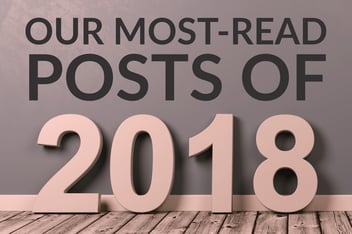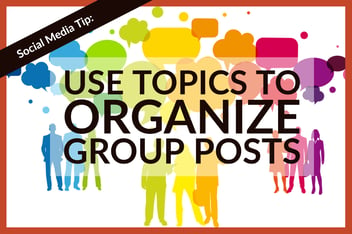Did You Miss 2018’s Greatest Inbound Marketing Blog Hits?

We strive to keep this Inbound Accelerator blog loaded with useful information, easy-to-understand infographics, and great insights into inbound marketing, public relations, and all the tactics and strategies involved in bringing those together. But when we published 2-5 posts every week, I know it isn’t always easy for readers to keep up and see every.single.post.
So, I thought I’d start 2019 by giving you a quick review of the posts published in 2018 that our readers flocked to most, so you can be sure to have seen the best of them. (Last week, I shared the most-read posts of 2018, including our entire blog library —those posts were all pre-2018 articles with fantastic staying power. I expect some of these to continue to build readership for years to come also.)
2018’s Greatest Blog Posts
1. Defining Lead Status: Cool, Warm, Hot
Not every lead or contact in your database has the same potential or needs the same things. They shouldn’t all get the same emails or see the same calls-to-action on your blog posts.
How do you decide which leads get which offers and content? We use a few ways of visualizing the status of contacts and leads. We talk about our content strategy as a funnel — wide at the top to reach as many potential prospects as possible, then narrow at the bottom to focus on the specific needs of those most likely to buy.
But how do you define the leads in those stages? Let’s think of it as a thermometer: cool, warm and hot.
Defining your leads’ status can help you segment and target marketing content, and this June 2018 post walks you through how to determine that status and what types of content to use for each stage.
2. Social Media Tip: Use Topics To Organize Group Posts
Facebook Groups provide businesses, including healthcare providers, with a vehicle for creating communities within their social media environment where followers, customers or patients can connect with others who have shared interests or experiences. (More on getting started with Facebook Groups here.)
If you build a successful group, with lots of activity, some organization may be in order to keep the group useful for all users. One way of doing so is to use “Topics” to organize posts within the group.
Go to the full post to read step-by-step instructions on using topics within your Facebook groups. And then check out our full series of Social Media Marketing Tips and other related posts here.
3. The ROI Of Marketing Automation
What makes marketing automation so beneficial?
The list of benefits is long, but the features of automation that are most essential for inbound marketers are those that improve performance of marketing campaigns, increase conversion of leads into sales, provide objective measurement of marketing efforts to prove ROI and attribute sales accurately.
JONES has worked with HubSpot for more than 5 years, and we love it for the same reasons Pardot praises marketing automation in the infographic provided at the end of this post.
Click through and scroll down to the infographic that lays out benefits of marketing automation such as a 53 percent higher conversion rate from marketing response to marketing qualified lead.
4. 5 Best Practices For Lead Nurturing Workflows
Lead nurturing, powered by marketing automation, is a powerful tool in the digital and content marketing arsenal, with the potential to create and strengthen connections between your brand and leads captured online through content and other offers.
While automation takes the drudgery and hands-on work out of connecting with each contact on a regular basis, planning and implementing the lead nurturing workflows of automated emails requires a detailed strategy, and is often confusing and susceptible to beginner’s blunders.
Read to the full post for 5 rules to follow to set your lead nurturing workflows on the right path.
5. What Brands Shouldn't Do On Social Media (infographic)
A strong social media presence is key for many businesses in reaching new customers, as younger generations of consumers increasingly turn to Facebook, Twitter, Instagram, and others for information, inspiration, recommendations and entertainment.
In fact, according to a Forbes survey on how social media impacts purchase decisions, 81 percent of consumers admit that recommendations and posts from family and friends directly impacted on their buying decisions, while 78 percent of people said social media posts of companies influence their buying decisions.
But social media users can be a fickle bunch. They may just as quickly unfollow your brand, as these results from a SproutSocial survey show.
Visit the full post for a visual look at mistakes that social media followers simply won’t tolerate.
6. Lead Generation Tops Digital Marketing Objectives In 2018
Ask a marketer what their strategies need to achieve to be successful, and the answer will almost invariably include one key objective: Increase lead generation.
Nearly every other objective is either a step that feeds into lead generation or relies on increased leads in order to succeed. Just check out the list below of objectives marketers told Ascend2 were most important for 2018.
Lead generation comes out on top — and successful lead generation is necessary to achieve the #2 objective: increased sales revenue.
Check out the other top objectives, and the most successful tactics, in the infographic highlighted in this blog post to see how they compare with your own experience.
7. B2B Marketing Content Preferences You Need To Know (infograpic)
B2B software buyers, and presumably other B2B buyers, are shifting their preferences when it comes to where they get information for making purchase decisions.
While word-of-mouth referrals are still cited by the majority of respondents to HubSpot’s 2017 State of Inbound Report, the number of buyers who mentioned word-of-mouth is decreasing (perhaps due to our increasingly electronic modes of communication and less face-to-face time with peers?).
But more are willing to consider B2B marketing content authored by the vendors themselves. In fact, just as many B2B buyers cited vendor-authored materials as a primary source of information as cited media articles.
Check out this infographic and interpretation to see what I think this shifting preference means for us as marketers.
8. Write For Readers, Not Search Engines, To Boost Blog SEO
Traditionally, a key element in optimizing web pages, including business blog posts, for organic search has been ensuring that targeted key words appear in specific locations on the page.
This kind of on-page SEO — using keywords in page titles, headings, image names, alt text, microdata and rich snippets — is still essential in signaling to search engines what the main point is of each of your blog posts.
But when keyword research and SEO consulting company SEMrush broke down several other factors to look at what made the difference between pages that landed in the top three positions in SERP rankings and those farther down the list, they found that the high search placement corresponded more closely with top results in a number of metrics that indicate reader behavior than with traditional on-page SEO.
Read on for more about how writing for readers — and your readers’ behavior — is the true key to search engine optimization.
9. Make Your Posts More Findable: 21 Business Blog SEO Tips
Search engine optimization, or SEO, is not a one-time project, especially if you publish a business blog to help drive website traffic.
(If you aren’t publishing a blog, here are a few reasons you should be: 3 Business Blogging Benefits You May Not Have Considered.)
While you may be able to go through the content of your website’s other pages once to get a good handle on whether you are following the essential rules for optimal keyword placement and avoiding mistakes that cost you ranking, a business blog requires thinking about SEO with every post you publish.
Visit the post to see an infographic shared by Red Website Design from the UK, and based on a blog post by Feldman Creative, which outlines 21 ways to improve your blog posts’ search rankings, both by placing keywords so they are recognizable by search engines and by creating posts that engage readers to encourage the kinds of reader signals that also influence SERP (hey, we just mentioned that in our #8 post in this list!).
10. 10 Tips To Improve Your Local SEO
Most small businesses will never be competitive with the giants when it comes to generic searches. Brands like Brooks and Nike, or major online retailers like Zappos and Running Warehouse, are going to come out on nearly any search for “running shoes,” with the local sporting goods store down the street struggling to hit the first page.
But when potential customers include a local geographic reference in their search, the small business has a chance to rise to the top, if they have paid attention to their on-page SEO.
This infographic from Jeyoo, which you’ll find when you visit the full blog post, offers 10 great tips for building a new local business website, or improving an existing one, to including the specific coding and key information that lets search engines know you are right around the corner.
As you can see, we touched on a lot of different topics over the last year — from lead nurturing to social media and SEO to ROI of marketing automation. That’s what you’ll continue to get from us in 2019 and beyond. This blog is my way of helping you learn more and do better. If you want to be sure you see more of these posts — even better, that you see ALL of them — click here to subscribe and choose whether you want to be notified of each new post ASAP, receive a weekly digest, or just get a monthly reminder that more great information and insights are available.
-1.png?width=1652&height=294&name=Jones(RGB)-1.png)











